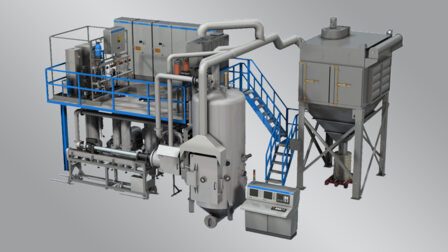Based on our long-proven and highly reliable ChamPro™ coating process, the LPPS-Hybrid system is designed for production coatings with unique features, such as:
- Typical chamber pressure from 0.5 mbar to 300 mbar during spray process
- Thermally grown oxide layer (TGO)
- High enthalpy plasma stream with high plasma torch output up to 150 kW
- Maximum spray part weight (incl. fixture) of 60 kg
- Spray part motion control by advanced CNC system, using 3 axes gun manipulator
These system features give rise to the advanced process characteristics of the vacuum plasma coating process:
- Very flexible operating conditions
- Application of thin or thick coatings
- Slow coating solidification controls residual stresses
- High deposition efficiency
- Special vacuum pumping system for high gas flows at low pressures
After the proper plasma conditions (chamber pressure, plasma power, gas flows, etc.) and part program are selected, the operator loads the workpiece directly onto the workpiece manipulator (the "sting") end. The loader is then retracted and the door closed. The transfer chamber is then evacuated and the system is activated. Upon completion of the evacuation procedure the part is carried on the sting into the spray chamber where it is pre-heated, transfer arc cleaned and plasma sprayed. After completion of spray process the part and sting return to the transfer chamber where the part is cooled and unloaded.
The LPPS-Hybrid system process produces a very high jet stream velocity and subsequent high particle velocity, giving the particles a high kinetic energy which results in a very dense coating structure. This can be compared to a forging process where the energy from impact produces fine-grain, dense material.
LPPS-Hybrid systems can produce coatings within three distinct regimes:
PS-PVD (Plasma Spray-PVD) can produce thick, columnar-structured YSZ coatings (100 to 300 µm) using high gun enthalpy to vaporize specific types of feedstock materials.
PS-CVD (Plasma Spray-CVD) uses modified conventional thermal spray components operated below 0.5 mbar to produce CVD-like coatings (<1 to 10 µm) at higher deposition rates by using liquid for gaseous precursors as feedstock materials.
PS-TF (Plasma Spray-Thin Film) can produce thin, dense layers from liquid splats using a classical thermal spray approach but at high velocity and enthalpy.

